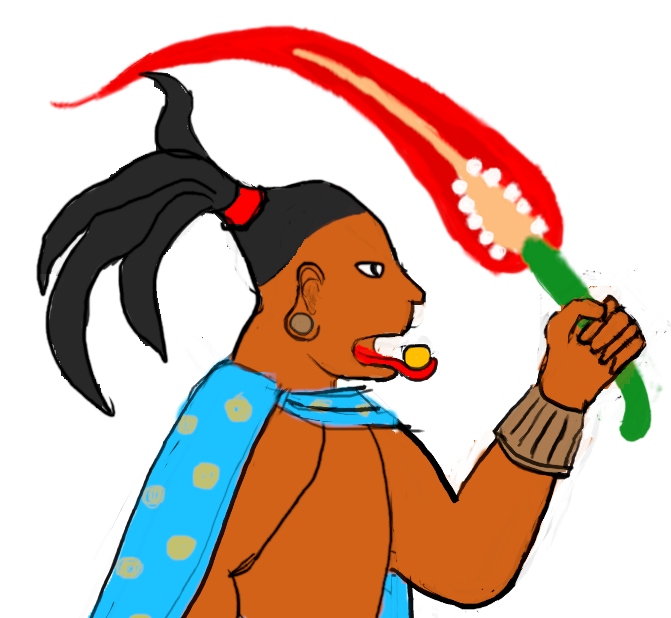Through Argul's sacrafice, the first rains came crashing down unto the lifeless stone world. With her lifeblood, life would be able to take it's first shape. - The Rakrabia, Verse 1:8
In the southern province of Mongrasil, a land dominated by dense jungles still mostly unclaimed by the
Roctane, lies the great Sulla Lekra River, the largest river in Stelwen. Sulla Lekra means Life Blood in Roctanik, a fitting name, for the river is home to many species who rely on the river's water for survival. For the Orkina faithful, the river is a symbol of life itself, for, without water, life would cease to exist in this beautiful world.
The Sulla Lekra Cult
The great Sulla Lekra river is a holy site and birthplace of its namesake cult. Members of this cult are devout worshippers of Argul, the Ancient God who sacrificed themselves to bring water to the world and subsequently allowed life to flourish in
Nostrina. Pinpointing exactly when this cult was first formed is difficult, though they were officially recognized by the Orkina Temple and fully registered as an authorized sect in 132 1E. Its members hail primarily from the local villages, though some pilgrims from other provinces comprise part of their ranks. Housed just outside of the town of Bal Meritak, south of the Sulla Lekra's source, the members of this cult reside alongside the riverbanks in their riverside temple. Members study the meaning of Argul's sacrifice within this temple, and newly initiated members are given their Sulla Lekra medallions, an enchanted piece of jewelry that allows the wearer to breathe underwater. These medallions are precious to the cultists, as it is what will enable them to access their sight of meditation safely. After pondering on the sacrifice that allowed life to exist and the very meaning of life, members will dive into the river wearing their medallions and swim to the riverbed. Once they reach the bottom of the river, they will find a spot of meditation that keeps them from being moved by the current, letting them clear their mind and ponder upon the very nature of life itself. Thanks to their medallions, they can mediate at the bottom of the river for as long as they desire.
Outside of their daily religious practices, the Sulla Lekra cult also plays a big part in the life of the Bal Meritak. Since they can stay in the river for far longer than others, the cult has become the primary harvesters of Narma fruits, establishing farms on the riverbed. Being the primary source of Narma in Stelwen, Bal Maritak became a trade hub and grew from a small village to an important stopping point along Stwlen's trade route. To keep cultists swimming in the river safe, sailing near the cult's temple is illegal. To prevent dangerous animals like crocodiles and Algratkrs from threatening both the town and cultists in the river, the locals constructed a barrier just outside of the temple grounds that allowed the current to flow normally while also keeping large animals out.
Local Ecology
The Sulla Lekra is home to various animals only found in and around this river. Rural villages living near the great river have become experts at catching some local fish species, including the Purple Longfin Eel, Mossy Cod, and Deep River Catfish. However, they must be careful of the Algratkr, a two-meter-long fish with armored plating and a ferocious bite. When wandering near the river's shore deep in the jungle, animals looking to drink from the river must watch for Sulla Lecka Crocodiles, the second largest species of crocodiles in the entire world, coming in at just over six meters long. Another significant predator lurking in the river is the Blue Bull Shark, a rare species of shark found in the southern parts of the river that can survive in both salt water and fresh water.
The plant life of the Sulla Lekra is also quite interesting. The herbivores of the Sulla Lekra often feed on Narma Fruits, which grow underwater at the bottom of the river. In the shallow parts of the river, the Nightglow flower blooms in abundance, using its glowing tip to attract nocturnal insects to its flowers for pollination. The locals are quite fond of the Lankr Flowers, a bright pink flower with a delightful odor to attract pollinators. Villagers living near the river often harvest this flower to create Lankr perfume and see the act of giving someone this flower as a symbol of love. However, not all plants are pleasant, as fish need to be aware of the Temptation Funnel, a carnivorous plant that lures fish with a glowing light. When the fish gets close and touches one of its vines, the vines take hold of the prey and consume it. Another unpleasant plant living near the Sulla Lekra is the Void Bloom, a black flower with stinging thorns along its stem filled with painful but non-lethal poison and strange pollen that can cause hallucinations for a short time.





It’s cool that you have a whole religious group based around this river, and even more interesting that they were able to encourage trade and improving the overall lives of the village. I would love to know more about the Narma fruits and other things that the cult cultivates or harvests in the river. Why is the fruit so profitable? Is it easy to farm for the cult members? Has the barrier ever failed and large animals gotten in to disturb or injure meditating cultists? Maybe the Ecology could be broken up into the individual species and listed on the sidebar? Overall a cool read!